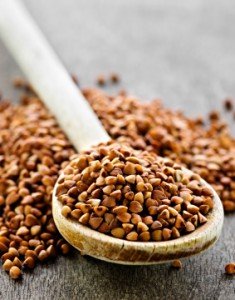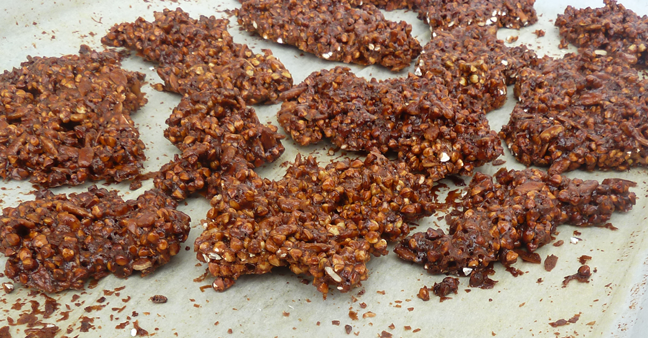Begging For Buckwheat
What is buckwheat?
Buckwheat isn't a wheat at all. In fact, it's a gluten-free powerhouse seed that acts like a grain while promoting healthy blood sugars and heart health.
An excellent source of fiber, 1 cup of buckwheat contains 17 grams of fiber. It's also a great source of the minerals such as magnesium, copper, and manganese. As well as a good source of iron, zinc, phosphorus, potassium, selenium, and B vitamins (especially niacin), the tiny buckwheat seed is a nutritional giant.
Buckwheat is high in protein with 12 grams in 1/2 cup (which is comparable to the amount contained in Greek yogurt). It's particularly high in the the essential amino acids lysine and arginine, which most major grains are deficient in. This unique amino acid composition has the power to boost the protein value of beans, lentils, and grains such as corn, rice, and wheat when eaten on the same day. It promotes collagen production and the absorption of calcium.
But the buck doesn't stop there. Due to its high level of magnesium, buckwheat has a relaxing effect on blood vessels, which improves circulation and decreases blood pressure. In addition, research has shown that people who eat buckwheat daily have lower total cholesterol and lower bad cholesterol (LDL) levels, while their good cholesterol (HDL) levels are increased. This lipid-lowering activity is largely due to the phytonutrient rutin, and other flavonoid compounds. In fact, rutin is extracted from the leaves of the buckwheat plant in order to manufacture medicine to treat high blood pressure.
When studies compared people's responses after they ate buckwheat and wheat, buckwheat appeared to help lower blood sugar and the corresponding insulin spikes, and to better satisfy hunger. Both the high fiber and magnesium in buckwheat may contribute to these favorable benefits, since fiber tends to slow down the absorption of sugar into the blood, and magnesium acts as a co-factor for enzymes involved in the body's use of glucose and insulin secretion. Another compound found in buckwheat called chiro-inositol may cause cells to be more sensitive to insulin and even mimics insulin. Buckwheat ranks lower on the glycemic scale than other grains such as rice, wheat, and corn that provoke a quick spike in blood sugar levels. These spikes cause greater levels of systemic inflammation.
Buckwheat comes in pale tan-to-green triangle-shaped kernels called raw buckwheat groats. Kasha, an integral part of Eastern European cuisine, is roasted buckwheat, and the roasting process makes the grain brown and crunchy and gives it a delicious nutty flavor. Add it as-is to yogurt, oatmeal, and salads for a crunchy topping. Both forms of buckwheat are typically found in the bulk section of the more health-oriented supermarkets. Buckwheat flour is also available. The good news is that buckwheat grows so quickly that it doesn't require pesticides or other chemicals to grow well.
Ways to eat buckwheat
If preparing a pilaf, tabouleh, or any other dish where individual grains are desired, take an extra five minutes or so and coat the kernels with egg or oil, then heat them in a skillet until dry; otherwise a sticky, mushy mess will ensue. Also limit the liquids for extra protection from this problem. Use one part whole groats, two parts boiling water or stock, and salt to taste. Cover and bake in a 350-degree oven for 15 to 20 minutes until the liquid has been absorbed.
Kasha is often steamed in a stock with onions, olive oil and fresh parsley. You can also combine and cook equal parts buckwheat groats and oats to make a hot breakfast cereal topped with fruit. Buckwheat has been cultivated for at least 1,000 years in China, Korea and Japan, where it is often enjoyed in the form of buckwheat soba noodles.
Try this delicious and easy Soba Noodle Asian Soup, or use the noodles in salads. This Spicy Soba Noodles with Eggplant dish is awesome even without the eggplant, and it doesn't have to be spicy to be good.
In France, a buckwheat crêpe is served in a square shape at any crêperie,with savory foods like eggs and cheese, and it is not called a crepe, but rather a galette. Crêpes and galettes are easy to make and can offer a healthy, fun food for the family.
Try these Egg and Cheese Galettes for a fast, healthy meal. Add a little cocoa powder to the batter and make a few Chocolate Crêpes filled with fruit for dessert. In the U.S., we are most familiar with adding buckwheat to make buckwheat pancakes, but it doesn't have to stop there. Buckwheat Brittle is a crunchy treat that is yummy enough to make buckwheat more popular.
Breton galette
However you serve it, buckwheat makes a healthy, nutty, and robust addition to any meal. While buckwheat is gluten-free, buckwheat noodles, crepes, and pancakes contain a mixture of wheat flour and buckwheat flour, and so are not gluten-free. However, Eden does sell a 100% gluten-free soba noodles, and gluten-free flour can easily be substituted for the wheat flour.
Buck up and take April's (2013) Healthy Challenge to add buckwheat to your diet. Use buckwheat flour in baked goods, use raw buckwheat groats or kasha (roasted buckwheat) in your recipes, and try to use soba noodles whenever possible to tap into buckwheat's superior nutrition.








